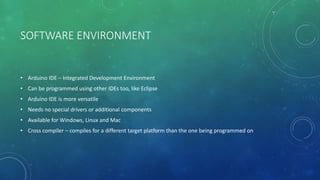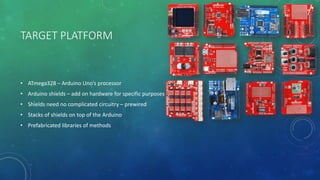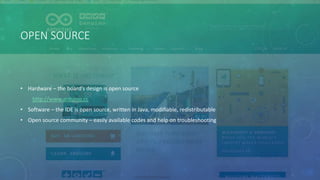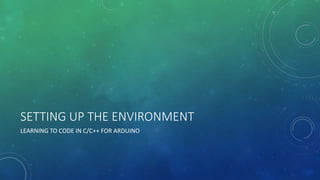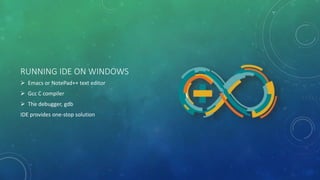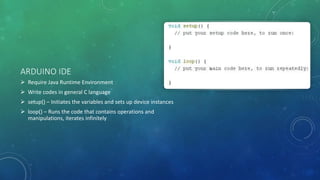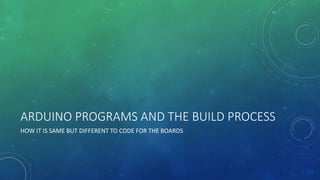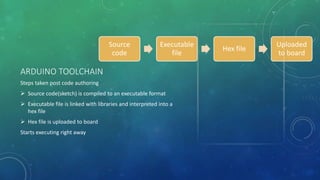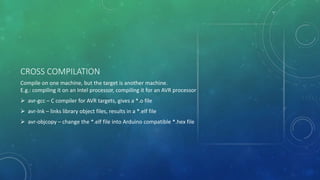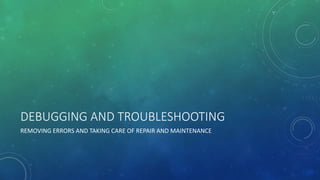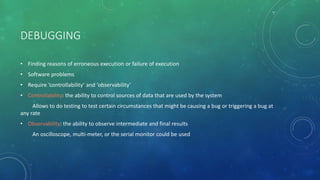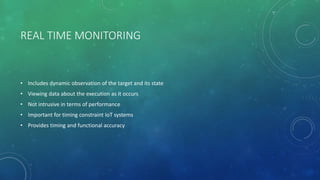Arduino and c programming
- 1. INTERNET OF THINGS: ARDUINO AND C PROGRAMMING COMBINING THE TANGIBLE AND THE VOLATILE INTO ONE Punit Goswami
- 2. ARDUINO ENVIRONMENT THE ARDUINO BOARD, ITS SOFTWARE COMPONENT AND OTHER ADD-ON HARDWARE
- 3. ARDUINO DEVELOPMENT BOARD • Eight bit microcontroller – brain of the board • USB Port – to communicate with the desktop/laptop • USB controller chip – manages USB transferred data • IO pins – board’s connection to the outside world • Quartz oscillator – board’s time keeper • Reset button – taking the board back to its initial state • External power jack – power from dedicated source Co-axial jack, but USB can also be used
- 4. INPUT/OUTPUT PINS (I/O PINS) Top and bottom rows of the board Holes in the board which we can stick wires in Holes are connected to the chips through traces on-board 14 Digital I/O pins on top [0-13] Highs – 5 volts Lows – 0 volts Max Current - 40 mA 6 Analog input pins on the bottom [A0 – A5] Power output pins on the bottom [ 5v , 3.3 v ] Reset pin to reset the board to initial state
- 5. MICROCONTROLLERS Two microcontrollers on the board Main ATmega328 – 8 bit microcontroller User programmable, runs user-written application code Carries firmware, like bootloader ATmega16U2 Handles the communication with the USB interface, not directly accessible
- 6. STORAGE & MEMORY Non-volatile flash memory for storage 32 kilobytes in size Static Random Access Memory (SRAM) for memory (volatile) 3 kilobytes in size
- 7. CLOCK 16 MHz clock speed ~ 16 million operations per second Helps synchronize all components together Keeping track of occurrence of events
- 8. PROGRAMMING FIRMWARE The ISCP headers can be used to program the firmware on the board ICSP1 for the main ATmega328 microcontroller ICSP2 for the ATmega16U2 microcontroller Special equipment are required in order to re-program the firmware through these headers
- 9. SOFTWARE ENVIRONMENT • Arduino IDE – Integrated Development Environment • Can be programmed using other IDEs too, like Eclipse • Arduino IDE is more versatile • Needs no special drivers or additional components • Available for Windows, Linux and Mac • Cross compiler – compiles for a different target platform than the one being programmed on
- 10. IDE – SOFTWARE TOOL FOR PROGRAMMING File operations and other general options on top Buttons for most commonly used options (Verify, Upload, etc.) Main window – Text editor for writing code Message area – for messages to the programmer
- 11. OPTIONS BUTTONS Buttons on the top have the most common ,useful operations Verify – compiles the code and checks for errors Uploads – compiles the code, uploads it to the board. Works only if the board is connected New – creates a new sketch, a new program Open – opens an existing sketch Save – saves the current sketch in the directory of your choice Serial Monitor – opens window to communicate with the board
- 12. TARGET PLATFORM • ATmega328 – Arduino Uno’s processor • Arduino shields – add on hardware for specific purposes • Shields need no complicated circuitry – prewired • Stacks of shields on top of the Arduino • Prefabricated libraries of methods
- 13. ARDUINO SHIELDS The prominent reason that Arduino got so popular Additional hardware to do particular, complex tasks Form of separate boards Pre-wired pins that stick into holes in Arduino Stack on top of the Arduino to make connections Pre-written functions for operations of these boards Open-source designs in most of the cases, third party Complete list of shields at http://www.shieldlist.org
- 14. OPEN SOURCE • Hardware – the board’s design is open source http://www.arduino.cc • Software – the IDE is open source, written in Java, modifiable, redistributable • Open source community – easily available codes and help on troubleshooting
- 15. SETTING UP THE ENVIRONMENT LEARNING TO CODE IN C/C++ FOR ARDUINO
- 16. RUNNING IDE ON WINDOWS Emacs or NotePad++ text editor Gcc C compiler The debugger, gdb IDE provides one-stop solution
- 17. ARDUINO IDE Require Java Runtime Environment Write codes in general C language setup() – Initiates the variables and sets up device instances loop() – Runs the code that contains operations and manipulations, iterates infinitely
- 18. BLINK LED EXAMPLE Pin 13 is represented by numeral 13 digitalWrite() writes voltage values to pins delay() sets delays in milliseconds HIGH – 5v LOW – 0v
- 19. ARDUINO PROGRAMS AND THE BUILD PROCESS HOW IT IS SAME BUT DIFFERENT TO CODE FOR THE BOARDS
- 20. Source code Executable file Hex file Uploaded to board ARDUINO TOOLCHAIN Steps taken post code authoring Source code(sketch) is compiled to an executable format Executable file is linked with libraries and interpreted into a hex file Hex file is uploaded to board Starts executing right away
- 21. CROSS COMPILATION Compile on one machine, but the target is another machine. E.g.: compiling it on an Intel processor, compiling it for an AVR processor avr-gcc – C compiler for AVR targets, gives a *.o file avr-lnk – links library object files, results in a *.elf file avr-objcopy – change the *.elf file into Arduino compatible *.hex file
- 22. DEBUGGING AND TROUBLESHOOTING REMOVING ERRORS AND TAKING CARE OF REPAIR AND MAINTENANCE
- 23. DEBUGGING • Finding reasons of erroneous execution or failure of execution • Software problems • Require ‘controllability’ and ‘observability’ • Controllability: the ability to control sources of data that are used by the system Allows to do testing to test certain circumstances that might be causing a bug or triggering a bug at any rate • Observability: the ability to observe intermediate and final results An oscilloscope, multi-meter, or the serial monitor could be used
- 24. REAL TIME MONITORING • Includes dynamic observation of the target and its state • Viewing data about the execution as it occurs • Not intrusive in terms of performance • Important for timing constraint IoT systems • Provides timing and functional accuracy
- 25. REMOTE DEBUGGING Remote Debugger • Host computer acts as debugger for a code that runs on the remote target system • Host computer are also the systems that the programmer programs on • Host provides the platform to interface with the debugging environment. • Provides good run control, not good for testing timing Embedded Debug Interface • Seen in modern processors, Arduino and its likes have trace macrocells • Built in to the processor • Hardware dedicated to do debugging directly
- 26. SERIAL PROTOCOLS FOR DEBUGGING • UART: Universal Asynchronous Receiver/Transmitter, an old protocol, still useful though. • Low hardware overhead • Transmits at 9600 baud • START and STOP buts are used for synchronization • The bits in between a START bit and the next STOP bit is the data • To distinguish, the receiver samples at 16 times higher rate than the baud rate • Serial interface can be used to both send data to and from the Arduino board
Editor's Notes
- #9: In circuit serial programmer




![INPUT/OUTPUT PINS (I/O PINS)
Top and bottom rows of the board
Holes in the board which we can stick wires in
Holes are connected to the chips through traces on-board
14 Digital I/O pins on top [0-13]
Highs – 5 volts Lows – 0 volts Max Current - 40 mA
6 Analog input pins on the bottom [A0 – A5]
Power output pins on the bottom [ 5v , 3.3 v ]
Reset pin to reset the board to initial state](https://image.slidesharecdn.com/arduinoandcprogramming-160123180133/85/Arduino-and-c-programming-4-320.jpg)




